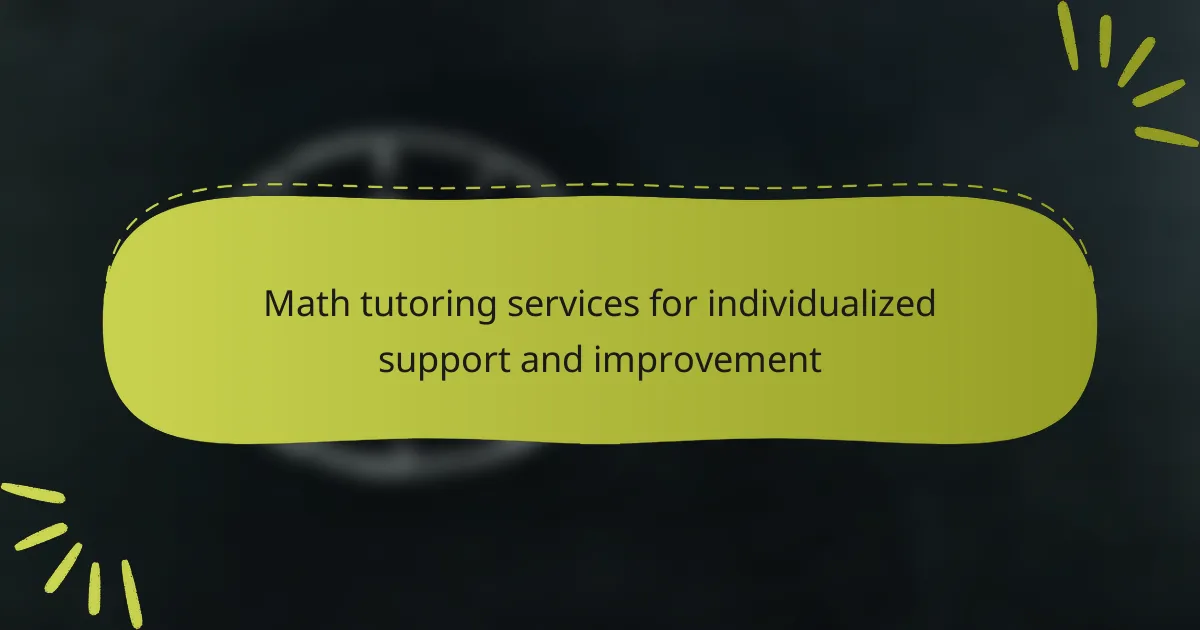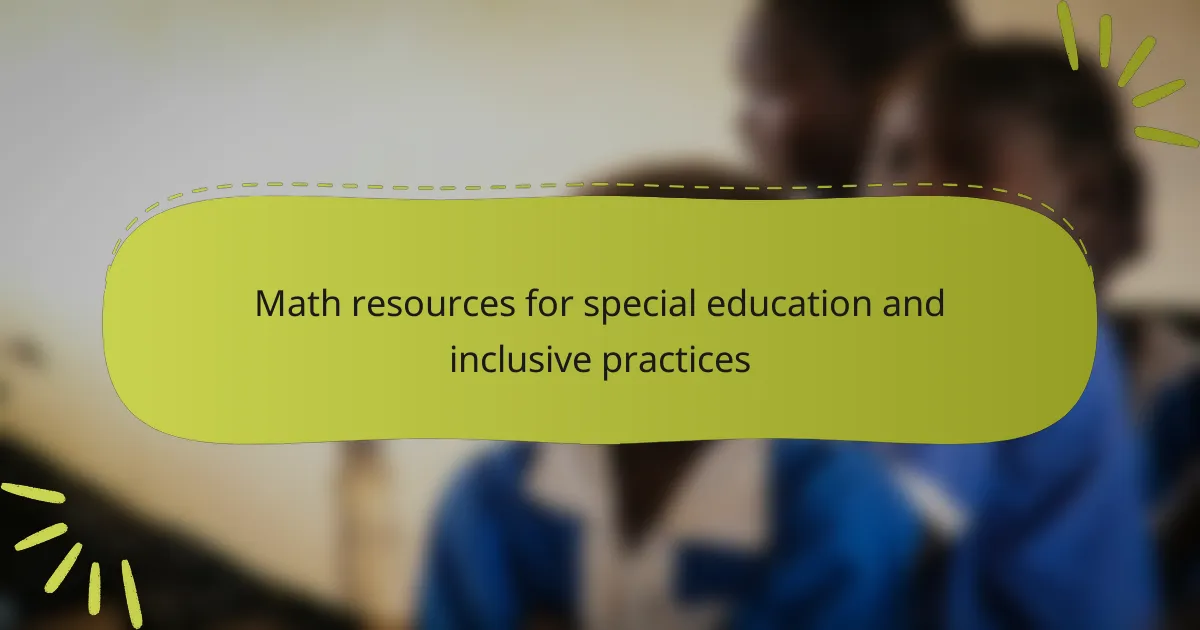Math manipulatives are physical tools designed to facilitate hands-on learning of mathematical concepts, including items such as blocks, counters, and measuring tools. These manipulatives enhance student engagement and retention by allowing learners to visualize abstract math ideas. Research indicates that the use of manipulatives positively impacts performance in math assessments, as demonstrated by studies from Clements and Sarama (2009) and the National Council of Teachers of Mathematics. The article discusses various types of manipulatives, including concrete objects, visual aids, and digital tools, and provides strategies for educators to effectively integrate these resources into lesson plans to support student learning and understanding of mathematical concepts.
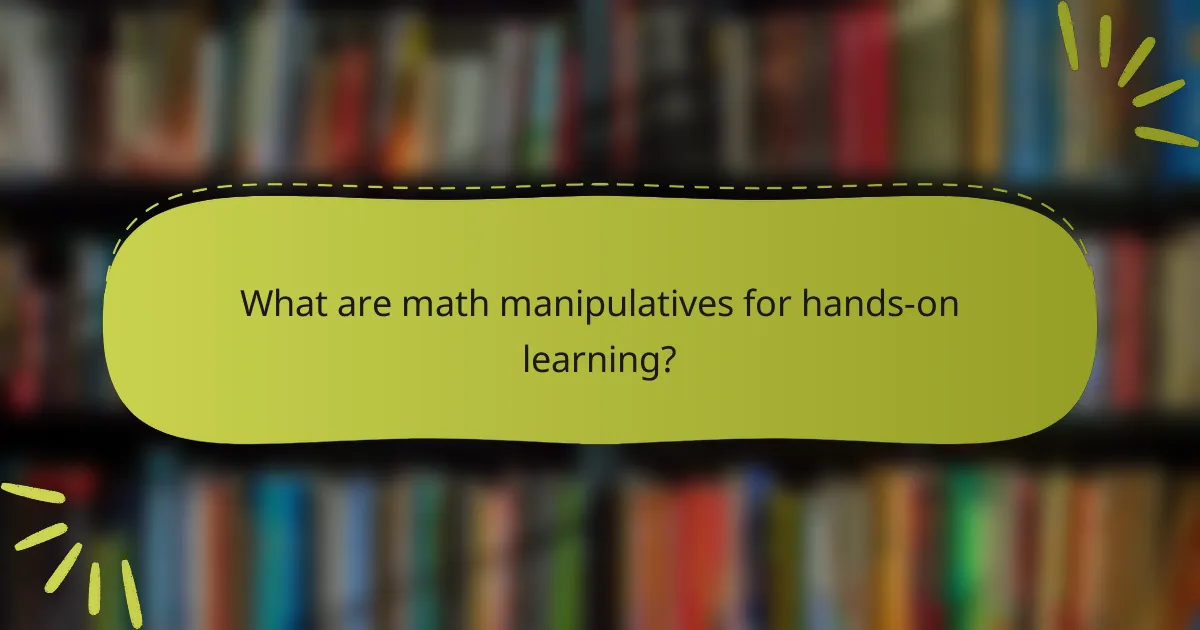
What are math manipulatives for hands-on learning?
Math manipulatives are physical tools used to teach mathematical concepts through hands-on learning. They include items like blocks, counters, and measuring tools. These manipulatives help students visualize and understand abstract math ideas. Research shows that using manipulatives can improve student engagement and retention of mathematical concepts. According to a study by Clements and Sarama (2009), children who use manipulatives perform better in math assessments. This evidence supports the effectiveness of math manipulatives in enhancing learning outcomes.
How do math manipulatives enhance understanding of mathematical concepts?
Math manipulatives enhance understanding of mathematical concepts by providing tactile and visual representations of abstract ideas. These tools allow learners to physically engage with numbers and operations. For instance, using blocks can help students grasp addition and subtraction by physically combining or separating them. Research indicates that students who use manipulatives perform better on math assessments. A study by Cramer et al. (2002) found that students using manipulatives scored significantly higher in understanding fractions. This hands-on approach fosters deeper comprehension and retention of mathematical principles.
What types of math concepts can be taught using manipulatives?
Manipulatives can teach various math concepts effectively. These include counting, addition, and subtraction. They also facilitate understanding of multiplication and division. Fractions can be visualized using manipulatives like fraction bars. Geometry concepts such as shapes and spatial relationships are easily demonstrated. Measurement concepts, including length and volume, can be explored with physical objects. Additionally, manipulatives help in teaching patterns and algebraic thinking. Research shows that hands-on learning enhances student engagement and comprehension in mathematics.
How do manipulatives cater to different learning styles?
Manipulatives cater to different learning styles by providing hands-on experiences that engage various senses. Visual learners benefit from seeing and handling physical objects. Kinesthetic learners thrive on tactile interaction, enhancing their understanding through movement. Auditory learners may gain insights from discussions about the manipulatives. Research shows that using manipulatives can improve retention and comprehension. A study by Clements and Sarama (2009) found that students using manipulatives performed better in math assessments. This approach supports differentiated instruction, allowing teachers to address diverse learning needs effectively.
Why are math manipulatives important in education?
Math manipulatives are important in education because they enhance understanding of mathematical concepts. These tools provide tactile experiences that engage students actively in learning. They allow learners to visualize abstract ideas, making them more concrete. Research shows that using manipulatives can improve problem-solving skills and retention of information. A study by Clements and Sarama (2009) found that children using manipulatives scored higher on math assessments than those who did not. This evidence supports the effectiveness of manipulatives in fostering mathematical comprehension.
What evidence supports the effectiveness of manipulatives in learning?
Manipulatives are effective tools in learning, particularly in mathematics. Research shows that they enhance understanding by allowing students to visualize abstract concepts. A study by Clements and Sarama (2009) found that students using manipulatives scored significantly higher on math assessments compared to those who did not. Additionally, the National Council of Teachers of Mathematics supports the use of manipulatives to improve problem-solving skills and conceptual understanding. Evidence from various educational settings indicates that manipulatives engage students and improve retention of mathematical concepts. Overall, the effectiveness of manipulatives in learning is well-documented through empirical research and educational best practices.
How do manipulatives promote engagement and motivation among students?
Manipulatives promote engagement and motivation among students by providing interactive, hands-on experiences. These tools allow students to visualize abstract concepts, making learning more tangible. When students manipulate physical objects, they can explore mathematical ideas actively. This active involvement enhances understanding and retention of information. Research shows that students using manipulatives perform better in math assessments. For instance, a study by Carbonneau, Marley, and Selig (2013) found that students using manipulatives scored significantly higher than those who did not. This demonstrates that manipulatives not only engage students but also improve their academic performance.
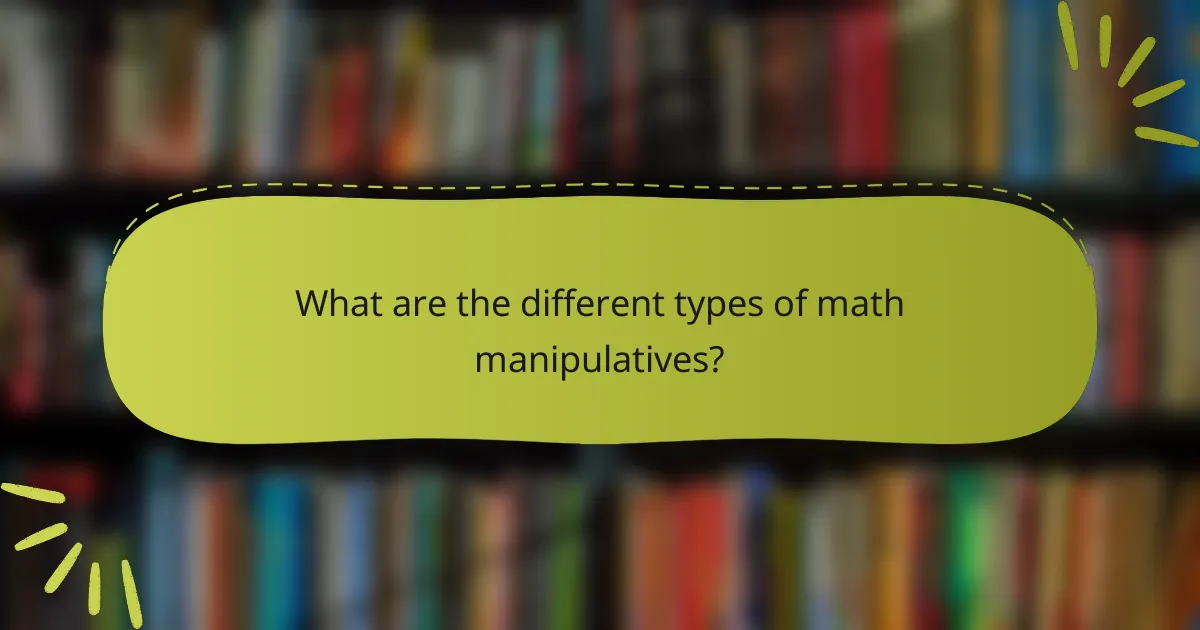
What are the different types of math manipulatives?
The different types of math manipulatives include concrete objects, visual aids, and digital tools. Concrete objects are physical items like blocks, counters, and measuring tools. Visual aids encompass charts, diagrams, and number lines. Digital tools include software and applications that simulate manipulative experiences. Each type serves to enhance understanding of mathematical concepts. Research shows that hands-on learning improves retention and engagement. For example, a study by the National Council of Teachers of Mathematics emphasizes the effectiveness of manipulatives in teaching.
What are concrete manipulatives and how are they used?
Concrete manipulatives are physical objects used to teach mathematical concepts. They help students understand abstract ideas through hands-on experience. Examples include blocks, counters, and shapes. These tools allow learners to visualize and physically manipulate numbers and relationships. Teachers employ concrete manipulatives to demonstrate addition, subtraction, and geometry. Research shows that using manipulatives improves student engagement and comprehension. A study by Clements and Sarama (2009) indicates that manipulatives enhance learning outcomes in early mathematics education.
What are examples of concrete manipulatives?
Examples of concrete manipulatives include base ten blocks, counting bears, and geometric shapes. Base ten blocks help students understand place value and addition. Counting bears are useful for teaching counting and basic operations. Geometric shapes assist in exploring spatial relationships and properties of shapes. Other examples are unifix cubes, which aid in addition and subtraction, and pattern blocks that support pattern recognition and symmetry. These manipulatives enhance hands-on learning and provide visual representations of mathematical concepts.
How do concrete manipulatives support tactile learning?
Concrete manipulatives enhance tactile learning by providing physical objects that students can touch and manipulate. This hands-on experience helps learners grasp mathematical concepts more effectively. Research shows that tactile interaction with manipulatives aids in understanding abstract ideas. For example, when students use blocks to represent numbers, they can visualize addition and subtraction. Studies indicate that students who engage with manipulatives perform better in math assessments. This approach caters to various learning styles, particularly kinesthetic learners. Overall, concrete manipulatives create an interactive learning environment that fosters deeper comprehension.
What are virtual manipulatives and their benefits?
Virtual manipulatives are digital tools that represent physical objects used to teach mathematical concepts. They provide interactive experiences for learners, allowing them to visualize and manipulate mathematical ideas. Benefits include enhanced engagement, as students can explore concepts in a dynamic way. They also promote individualized learning, accommodating different learning paces. Research indicates that virtual manipulatives can improve understanding of abstract concepts. A study by Moyer-Packenham and Suh (2013) found that students using virtual manipulatives showed greater conceptual understanding than those using traditional methods. Additionally, they can be easily accessed on various devices, making them versatile for classroom and remote learning.
How do virtual manipulatives differ from concrete ones?
Virtual manipulatives are digital tools used for teaching mathematical concepts, while concrete manipulatives are physical objects. Virtual manipulatives can be accessed through computers or tablets, allowing for interactive learning experiences. Concrete manipulatives require physical handling, which can enhance tactile learning.
Virtual manipulatives often provide instant feedback and can simulate complex scenarios that may be difficult with physical objects. Concrete manipulatives can help students develop fine motor skills through physical manipulation. Research shows that both types can effectively support learning, but they cater to different learning styles. Studies indicate that combining both can lead to improved understanding of mathematical concepts.
What platforms provide effective virtual manipulatives?
Platforms that provide effective virtual manipulatives include Google Slides, Desmos, and GeoGebra. Google Slides allows users to create interactive presentations with manipulatives. Desmos offers a graphing calculator that supports dynamic visualizations. GeoGebra combines geometry, algebra, and calculus in an interactive environment. Each platform enhances engagement and understanding in math. Studies show that interactive tools improve learning outcomes in mathematics.
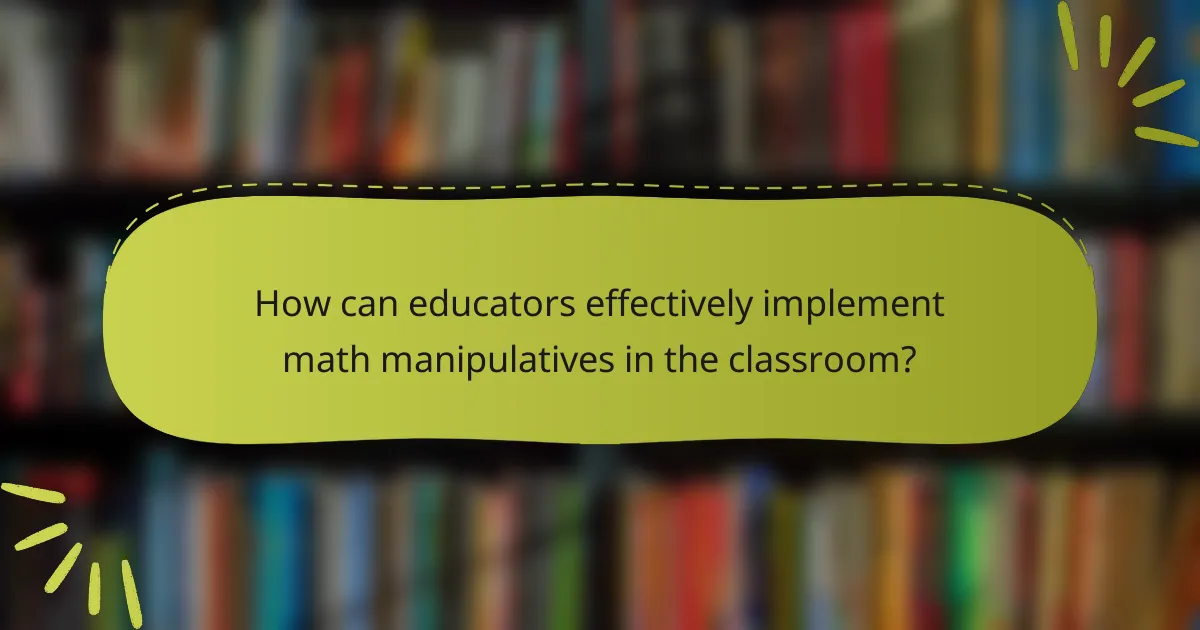
How can educators effectively implement math manipulatives in the classroom?
Educators can effectively implement math manipulatives in the classroom by integrating them into lesson plans. This involves selecting manipulatives that align with specific learning objectives. For example, using base ten blocks can help students understand place value. Teachers should demonstrate how to use these tools during direct instruction. Providing opportunities for guided practice allows students to explore manipulatives with support. Encouraging independent exploration fosters a deeper understanding of mathematical concepts. Regularly assessing student understanding is crucial to gauge the effectiveness of manipulatives. Research shows that hands-on learning increases student engagement and retention of mathematical concepts.
What strategies can teachers use to integrate manipulatives into lessons?
Teachers can integrate manipulatives into lessons by using hands-on activities that engage students. One effective strategy is to incorporate manipulatives during direct instruction. This allows students to visualize concepts as they learn. Another approach is to use group work, where students collaborate with manipulatives to solve problems. This encourages peer learning and communication. Teachers can also create centers with various manipulatives for independent exploration. This fosters self-directed learning and critical thinking. Additionally, aligning manipulatives with learning objectives ensures they support the curriculum effectively. Research shows that students retain information better when they actively engage with materials.
How can manipulatives be aligned with curriculum standards?
Manipulatives can be aligned with curriculum standards by ensuring they support specific learning objectives. Teachers should identify the standards relevant to their lessons. Then, they can select manipulatives that facilitate the understanding of these objectives. For example, if a standard emphasizes addition and subtraction, using base ten blocks can help students visualize these operations. Research shows that manipulatives enhance conceptual understanding and engagement in math. According to the National Council of Teachers of Mathematics, effective use of manipulatives aligns with best practices in teaching mathematics. This alignment promotes deeper learning and retention of mathematical concepts.
What are some common challenges teachers face when using manipulatives?
Teachers face several challenges when using manipulatives in the classroom. One common issue is classroom management. Manipulatives can lead to distractions if not properly monitored. Another challenge is the varying levels of student engagement. Some students may not grasp the concepts being taught, despite using manipulatives. Additionally, teachers may struggle with the time required to prepare and implement lessons that incorporate manipulatives. Limited training on effective use can also hinder their effectiveness. Lastly, the cost of materials can be a barrier for some schools. Research shows that these challenges can impact the overall effectiveness of manipulatives in enhancing learning outcomes.
What tips can educators follow for successful use of math manipulatives?
Educators can enhance the successful use of math manipulatives by incorporating specific strategies. First, they should select manipulatives that align with learning objectives. This ensures that the tools are relevant to the concepts being taught. Second, educators should model the use of manipulatives before allowing students to explore independently. This provides students with a clear understanding of how to use the tools effectively. Third, they should encourage collaborative learning by having students work in pairs or small groups. Collaboration fosters discussion and deeper understanding of mathematical concepts.
Additionally, educators should regularly assess students’ understanding through observation during manipulative activities. This allows for timely feedback and adjustments to instruction. They should also integrate manipulatives into various teaching methods, including direct instruction and guided discovery. This variety keeps students engaged and caters to different learning styles. Finally, educators must reflect on the effectiveness of using manipulatives and adjust their strategies as needed. Continuous improvement is key to successful implementation.
How can teachers assess student understanding when using manipulatives?
Teachers can assess student understanding when using manipulatives through observation and questioning. They can observe how students interact with the manipulatives. This includes noting their problem-solving strategies and engagement levels. Teachers can ask targeted questions to gauge comprehension. These questions can prompt students to explain their reasoning and thought processes. Additionally, teachers can use formative assessments, such as exit tickets or quick quizzes. This allows for immediate feedback on students’ grasp of concepts. Research indicates that hands-on activities enhance understanding and retention. For example, a study by Clements and Sarama (2009) found that manipulatives improve mathematical learning outcomes.
What are best practices for maintaining and organizing manipulatives?
Best practices for maintaining and organizing manipulatives include categorizing items by type and usage. Proper storage in labeled bins enhances accessibility. Regular inventory checks prevent loss and damage. Cleaning manipulatives after use ensures hygiene and longevity. Establishing a routine for organizing helps maintain order. Training students on proper handling promotes responsibility. Creating a designated space for manipulatives minimizes clutter. These practices support effective learning environments and facilitate hands-on activities.
Math manipulatives are physical tools that facilitate hands-on learning of mathematical concepts, including blocks, counters, and measuring tools. They enhance understanding by providing tactile and visual representations of abstract ideas, catering to various learning styles and improving student engagement and retention. The article explores the types of math concepts that can be taught using manipulatives, their effectiveness supported by research, and strategies for educators to implement them effectively in the classroom. Additionally, it addresses common challenges and best practices for maintaining and organizing these tools to maximize their educational benefits.

